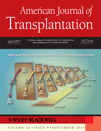Preventing CMV Viremia and Disease 3–6 Months After Renal Transplantation
To the Editor:
The letter by Mossad et al. raises some important issues regarding strategies for preventing CMV disease occurring after completion of antiviral prophylaxis (i.e. late-onset CMV). It is correct that in the IMPACT trial, for patients receiving 100 days of prophylaxis, the majority of late-onset disease occurred between month 3 and month 6 posttransplant (1). I agree that routine virologic monitoring after completing 100 days of prophylaxis (a hybrid prophylaxis/pre-emptive strategy) may be an alternative prevention approach (vs prolongation of prophylaxis). However, based on the current literature it is unclear what the comparative efficacy of this would be for the prevention of late-onset disease. In one study analyzing the potential value of such a strategy after completing of a 3 month course of antiviral prophylaxis, routine viral load monitoring would have predicted late-onset disease in only 24/64 (38%) cases (2). Since in vivo viral doubling time may be quite rapid in high-risk transplant patients (in the range of 1–2 days) (3), it may be that more intensive viral load monitoring (e.g. weekly) would be required in order to prove effective in preventing disease. Such intensive monitoring may be logistically difficult in some settings once patients are beyond 3 months posttransplant.
Ideally a randomized trial comparing prolonged prophylaxis versus a hybrid prophylaxis/pre-emptive approach would help better define the best method for prevention of late-onset disease. Alternatively the use of better predictive tools such as cell mediated immunity assessments, may allow a more individually tailored approach for prophylaxis in the future. More simple measurements of immune response such as seroconversion in donor-seropositive/recipient-seronegative patients (D+/R–) do not appear to have significant clinical utility for prediction of late-onset CMV disease (4). However, assessment of CMV-specific CD4+ or CD8+ T-cell responses may be more useful for predicting late-onset disease. For example, detection of CMV-specific CD4+ T cells was associated with protection from subsequent viremia in a cohort of kidney transplant recipients (5). However, more data is needed on the predictive value of such assessments before they can be adopted into routine clinical practice.
References
Disclosure
The author of this manuscript has conflicts of interest to disclose as described by the American Journal of Transplantation. Atul Humar has received grant support and/or honoraria from Roche, Astellas, Pfizer and CSL Behring.




